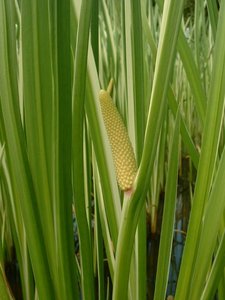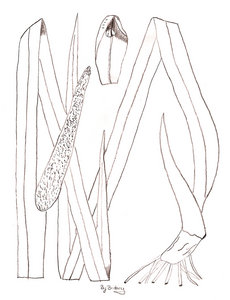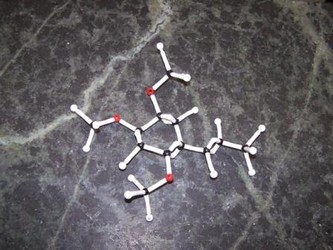

Acorus calamus. Photograph © J. F. Gaffard, drawing © 1sagebrush1.
Lakota name: Hohwá (This word refers to the leaves; the leaves and stalks are eaten.)
 Listen to Lakota Plant Name: Hohwá
Listen to Lakota Plant Name: Hohwá
Scientific name: Acorus calamus
Common name: sweet flag or calamus
Lakota medicinal use: pulverized, mixed with gunpowder, and used as a medicine for cramps of arms and legs.
Medicinal uses by other cultures: Calamus root was used as a home remedy for colic. The rhizomes of Acorus calamus contain aromatic oils that have been used medicinally since ancient times and have been harvested commercially. Native Americans exploited Acorus as a medicine and for ceremonial uses. Although this plant is cited in the ethnographic and ethnobotanical literature as Acorus calamus, the distribution of the tribes reported to use Acorus corresponds to the range of the native species.
The root is carminative, slightly tonic, and excitant, and forms a stimulant. It may be used in cases of flatulence, colic, atonic dyspepsia, feebleness of the digestive organs, and to aid the action of cinchona or quinine in intermittents. It forms an excellent substitute, in syrup, for Godfrey's cordial. Externally, it is a valuable application to the skin, and to keep up the discharges from blistered surfaces and issues.
Active compounds produced by this plant: Acorus calamus produces beta-asarone which is a genotoxic (capable of causing genetic mutation and contributing to tumors) phenylpropanoid (produced by plants for defense against herbivores and protection against ultra-violet rays). In an experiment beta-asarone was shown to be active in inducing liver tumours.

Click on an image to view larger version & data in a new window

Molecular structure of beta-asarone © 1sagebrush1
Description: Acorus calamus is a grass like perennial, pale to dark brown and spongy on the inside, up to 80 cm long, linear to narrowly ensiform or sword shaped, glossy bright green. Acorus calamus is sterile, due to the fact that it has a triploid number of chromosomes (having a chromosome number that is 3 times the basic or haploid number).
Similar species: Acorus gramineus, Acorus americanus
Flowering time: May to August
Habitat: streams banks and marshes
Information on the Internet
Education Standards
State Education Standards
- South Dakota Education Standards
- 9-12.L.1.1. Students are able to relate cellular functions and processes to specialized structures within cells.
- 9-12.L.1.2. Students are able to classify organisms using characteristics and evolutionary relationships of major taxa.
- 9-12.S.1.1. Students are able to explain ethical roles and responsibilities of scientists and scientific research.
- 9-12.S.1.2. Students are able to evaluate and describe the impact of scientific discoveries on historical events and social, economic, and ethical issues.
- 9-12.N.1.1. Students are able to evaluate a scientific discovery to determine and describe how societal, cultural, and personal beliefs influence scientific investigations and interpretations.
- 9-12.N.2.1. Students are able to apply science process skills to design and conduct student investigations. (Synthesis)
- 9-12.N.2.2. Students are able to practice safe and effective laboratory techniques.
National Education Standards
- National Education Standards
CONTENT STANDARD A: As a result of activities in grades 9-12, all students should develop
- Abilities necessary to do scientific inquiry
- Understandings about scientific inquiry
CONTENT STANDARD B: As a result of their activities in grades 9-12, all students should develop an understanding of
- Structure of atoms
- Structure and properties of matter
- Chemical reactions
- Motions and forces
- Conservation of energy and increase in disorder
- Interactions of energy and matter
CONTENT STANDARD C: As a result of their activities in grades 9-12, all students should develop understanding of
- The cell
- Molecular basis of heredity
- Biological evolution
- Interdependence of organisms
- Matter, energy, and organization in living systems
- Behavior of organisms
CONTENT STANDARD E: As a result of activities in grades 9-12, all students should develop
- Abilities of technological design
- Understandings about science and technology
CONTENT STANDARD F: As a result of activities in grades 9-12, all students should develop understanding of
- Personal and community health
- Population growth
- Natural resources
- Environmental quality
- Natural and human-induced hazards
- Science and technology in local, national, and global challenges
CONTENT STANDARD G: As a result of activities in grades 9-12, all students should develop understanding of
- Science as a human endeavor
- Nature of scientific knowledge
- Historical perspectives
About This Page
Page copyright © 2008
 Page: Tree of Life
Acorus calamus a.k.a. Sweet Flag by Brittany
The TEXT of this page is licensed under the
Creative Commons Attribution-NonCommercial License - Version 3.0. Note that images and other media
featured on this page are each governed by their own license, and they may or may not be available
for reuse. Click on an image or a media link to access the media data window, which provides the
relevant licensing information. For the general terms and conditions of ToL material reuse and
redistribution, please see the Tree of Life Copyright
Policies.
Page: Tree of Life
Acorus calamus a.k.a. Sweet Flag by Brittany
The TEXT of this page is licensed under the
Creative Commons Attribution-NonCommercial License - Version 3.0. Note that images and other media
featured on this page are each governed by their own license, and they may or may not be available
for reuse. Click on an image or a media link to access the media data window, which provides the
relevant licensing information. For the general terms and conditions of ToL material reuse and
redistribution, please see the Tree of Life Copyright
Policies.
About This Portfolio
I would like to acknowledge the following individuals for their help with this project:
- Rev. Raymond Bucko S.J., Creighton University Department of Sociology and Anthropology
- My student mentor Devan, Kim Loeffen, Tony Beisiot, Wade Mackey, and Sharon Burns for their technical help.
- F.J. Doody, Buechel Memorial Museum, St. Francis, S.D.
- Ben Black Bear Jr. for his audio of Lakota names, St. Francis, S.D. (Author of the Introduction of Dilwyn Rogers' Book of Father Buechel's research.)
- Katja Schulz Managing Editor ToL
- And mostly, my students for their perserverence!
Robin Cochran-Dirksen

Lead-Deadwood High School
Correspondence regarding this page should be directed to Robin Cochran-Dirksen at
Page copyright © 2008 Robin Cochran-Dirksen
 Listen to Lakota Plant Name: Hohwá
Listen to Lakota Plant Name: Hohwá








 Go to quick links
Go to quick search
Go to navigation for this section of the ToL site
Go to detailed links for the ToL site
Go to quick links
Go to quick search
Go to navigation for this section of the ToL site
Go to detailed links for the ToL site